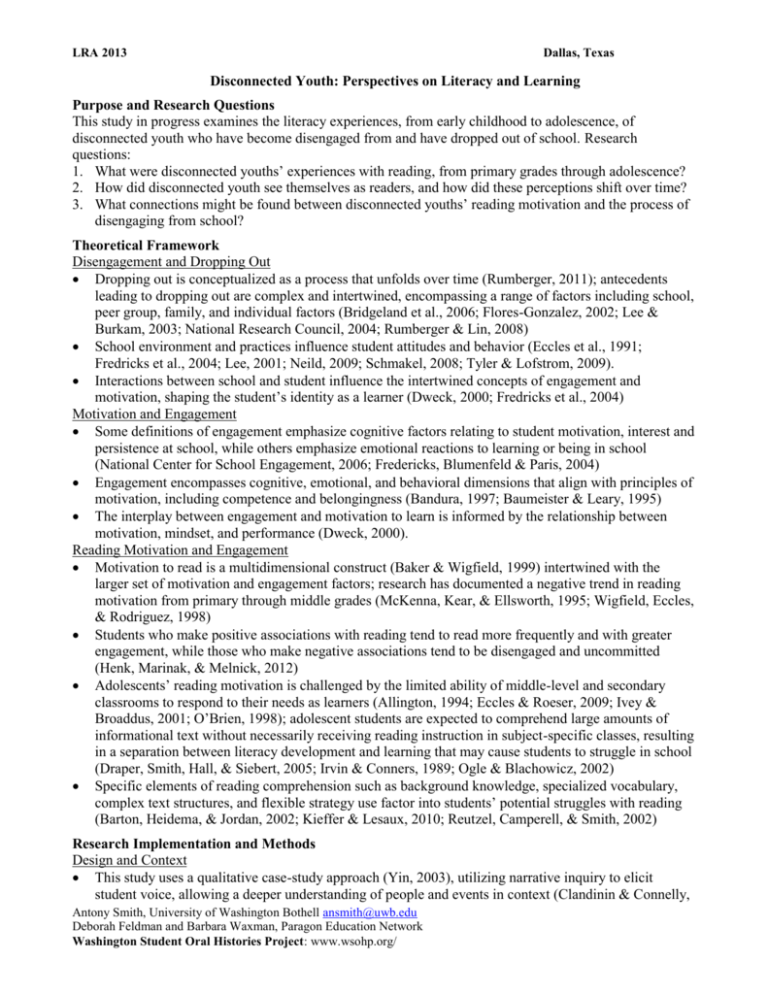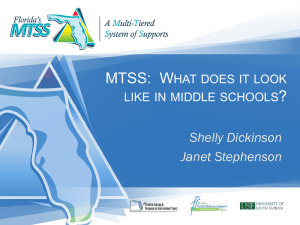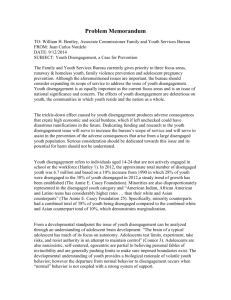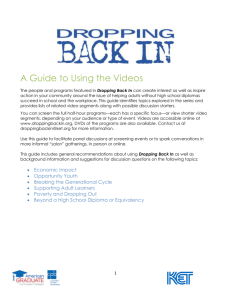LRA 2013 Dallas, Texas Disconnected Youth: Perspectives on
advertisement

LRA 2013 Dallas, Texas Disconnected Youth: Perspectives on Literacy and Learning Purpose and Research Questions This study in progress examines the literacy experiences, from early childhood to adolescence, of disconnected youth who have become disengaged from and have dropped out of school. Research questions: 1. What were disconnected youths’ experiences with reading, from primary grades through adolescence? 2. How did disconnected youth see themselves as readers, and how did these perceptions shift over time? 3. What connections might be found between disconnected youths’ reading motivation and the process of disengaging from school? Theoretical Framework Disengagement and Dropping Out Dropping out is conceptualized as a process that unfolds over time (Rumberger, 2011); antecedents leading to dropping out are complex and intertwined, encompassing a range of factors including school, peer group, family, and individual factors (Bridgeland et al., 2006; Flores-Gonzalez, 2002; Lee & Burkam, 2003; National Research Council, 2004; Rumberger & Lin, 2008) School environment and practices influence student attitudes and behavior (Eccles et al., 1991; Fredricks et al., 2004; Lee, 2001; Neild, 2009; Schmakel, 2008; Tyler & Lofstrom, 2009). Interactions between school and student influence the intertwined concepts of engagement and motivation, shaping the student’s identity as a learner (Dweck, 2000; Fredricks et al., 2004) Motivation and Engagement Some definitions of engagement emphasize cognitive factors relating to student motivation, interest and persistence at school, while others emphasize emotional reactions to learning or being in school (National Center for School Engagement, 2006; Fredericks, Blumenfeld & Paris, 2004) Engagement encompasses cognitive, emotional, and behavioral dimensions that align with principles of motivation, including competence and belongingness (Bandura, 1997; Baumeister & Leary, 1995) The interplay between engagement and motivation to learn is informed by the relationship between motivation, mindset, and performance (Dweck, 2000). Reading Motivation and Engagement Motivation to read is a multidimensional construct (Baker & Wigfield, 1999) intertwined with the larger set of motivation and engagement factors; research has documented a negative trend in reading motivation from primary through middle grades (McKenna, Kear, & Ellsworth, 1995; Wigfield, Eccles, & Rodriguez, 1998) Students who make positive associations with reading tend to read more frequently and with greater engagement, while those who make negative associations tend to be disengaged and uncommitted (Henk, Marinak, & Melnick, 2012) Adolescents’ reading motivation is challenged by the limited ability of middle-level and secondary classrooms to respond to their needs as learners (Allington, 1994; Eccles & Roeser, 2009; Ivey & Broaddus, 2001; O’Brien, 1998); adolescent students are expected to comprehend large amounts of informational text without necessarily receiving reading instruction in subject-specific classes, resulting in a separation between literacy development and learning that may cause students to struggle in school (Draper, Smith, Hall, & Siebert, 2005; Irvin & Conners, 1989; Ogle & Blachowicz, 2002) Specific elements of reading comprehension such as background knowledge, specialized vocabulary, complex text structures, and flexible strategy use factor into students’ potential struggles with reading (Barton, Heidema, & Jordan, 2002; Kieffer & Lesaux, 2010; Reutzel, Camperell, & Smith, 2002) Research Implementation and Methods Design and Context This study uses a qualitative case-study approach (Yin, 2003), utilizing narrative inquiry to elicit student voice, allowing a deeper understanding of people and events in context (Clandinin & Connelly, Antony Smith, University of Washington Bothell ansmith@uwb.edu Deborah Feldman and Barbara Waxman, Paragon Education Network Washington Student Oral Histories Project: www.wsohp.org/ LRA 2013 Dallas, Texas 2000) and providing coherence to interpreting qualitative data (Lieblich, Tuval-Mashiach, & Zilber, 1998) Participants included 53 youth, ages 16-22, who had dropped out of school; youth were located through urban and rural alternative school and social service agencies Data Sources and Analysis Screening survey Semi-structured interview protocol (Patton, 2002) School rating form (completed and discussed during the interview) Interview transcripts were analyzed using open coding (Strauss & Corbin, 1998) to identify themes within and across cases, leading to the development of theoretical propositions exploring these emerging themes (Miles & Huberman, 1994) A 4-part report of general results relating to motivation, engagement, the disengagement process, and drop-out initiating and tipping points may be found at www.wsohp.org Emerging Results Disengagement and Reading: A Long-Term Process Youths’ stories suggest dropping out is not so much a well-defined event as a long-term process of disengagement that may start as early as elementary school. Literacy experiences are interwoven with this process. In primary grades, students appeared to enjoy most aspects of school despite learning challenges or behavioral problems. Literacy experiences were remembered fondly, with teacher read-alouds and independent reading involving student choice noted as highlights. Students most often considered themselves ‘good readers’ in early grades, though this seemed to reference decoding skills rather than comprehension. As one youth described, “I liked reading. We had reading time in the morning and I always thought that was cool. And I liked seeing friends…In the beginning years, it was the teacher [who]would read to us and like fourth, fifth and sixth grade we got to read ourselves Middle level years showed emerging elements of disengagement, with youth skipping first a few classes and then moving to serious truancy early in high school. Some youth appeared to move quickly into serious truancy while others experienced a slow dropping out process lasting years. During this time, perceptions of literacy seemed to decay, particularly in terms of motivation. Faced with challenging texts in ‘boring’ classes, many youth recalled giving up school reading, or worse, stopping altogether. As one youth recalled, “I hate reading out loud ‘cause I’m not a good reader. That really got me, too. So I would like – for me, it would be like I make jokes so I wouldn’t have to read out loud. I would get myself in trouble so I wouldn’t have to do it and they would kick me out of my class, and I would be in the office.” From the stories youth told us, reading in middle grades (and beyond) was neither personal nor relational. Instead, disengaged reading folded into the larger process of disconnecting from school, leading youth down the pathway to dropping out of school. These experiences lead to the question: Could engaged reading in middle and high school have helped divert youth from the pathway to dropping out? Perhaps not, as multiple factors beyond school contributed to the process of dropping out. Academic mindset, the belief that one is able to do work and has the intelligence necessary to succeed, appeared to be a powerful factor influencing youths’ school failure. Perhaps academic mindset could be boosted by fostering engaged reading through shifts in middle school curriculum and instruction. Shifts like these may help at-risk students improve skills and see themselves as successful readers who are part of a larger reading community (Ivey & Johnston, 2013). Engaged reading may make it possible for disconnected youth to build confidence, persevere in completing reading and academic tasks, graduate on time, and ultimately become lifelong readers who are motivated to learn. Antony Smith, University of Washington Bothell ansmith@uwb.edu Deborah Feldman and Barbara Waxman, Paragon Education Network Washington Student Oral Histories Project: www.wsohp.org/











